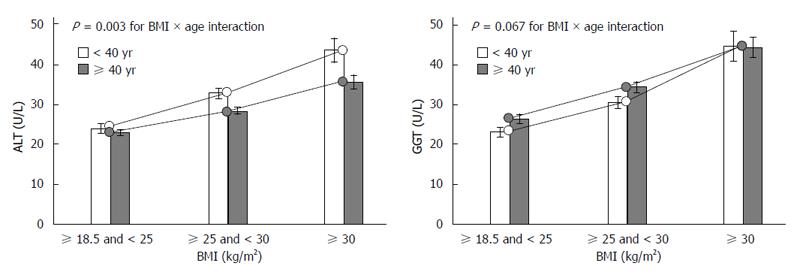Copyright
©2014 Baishideng Publishing Group Inc.
World J Gastroenterol. Sep 7, 2014; 20(33): 11743-11752
Published online Sep 7, 2014. doi: 10.3748/wjg.v20.i33.11743
Published online Sep 7, 2014. doi: 10.3748/wjg.v20.i33.11743
Figure 1 Alanine aminotransferase and gamma-glutamyltransferase levels (geometric mean ± 95%CI) in men and women classified to subgroups according to age.
Horizontal lines indicate significant differences between groups, as assessed by ANOVA with Bonferroni post hoc test. Alcohol intake (drinks/wk), BMI (kg/m2), smoking (cigarettes/d), and coffee consumption (cups/d) were used as covariates. ALT: Alanine aminotransferase; GGT: Gamma-glutamyltransferase.
Figure 2 Interactions of ethanol intake with age on alanine aminotransferase and gamma-glutamyltransferase levels in men.
An aggravated effect of ethanol was seen in those who were over 40 years of age and consumed over 16 drinks of alcohol per week. In women, the interaction between alcohol use and age was not significant (Table 3). Smoking and coffee consumption were used as covariates. ALT: Alanine aminotransferase; GGT: Gamma-glutamyltransferase.
Figure 3 Interactions of body mass index with age on alanine aminotransferase and gamma-glutamyltransferase levels.
A significant interaction was noted only on alanine aminotransferase (ALT) levels in men below 40 years of age. Alcohol intake, smoking and coffee consumption were used as covariates. BMI: Body mass index.
Figure 4 Interactions of ethanol intake with body mass index on alanine aminotransferase and gamma-glutamyltransferase levels.
Significant interactions in both men and women were noted for gamma-glutamyltransferase (GGT), whereas not for alanine aminotransferase (ALT). Covariates used were age (years), smoking, and coffee consumption. BMI: Body mass index.
- Citation: Danielsson J, Kangastupa P, Laatikainen T, Aalto M, Niemelä O. Impacts of common factors of life style on serum liver enzymes. World J Gastroenterol 2014; 20(33): 11743-11752
- URL: https://www.wjgnet.com/1007-9327/full/v20/i33/11743.htm
- DOI: https://dx.doi.org/10.3748/wjg.v20.i33.11743












